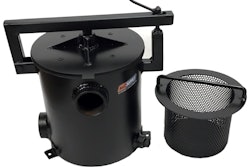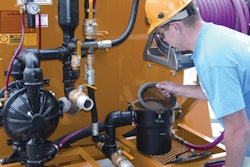When you invest in a machine like a sealcoating tank, you want it to last a long time and to work properly in order to bring in profits. The most important thing you can do to keep your machinery working is to perform routine maintenance on it. Most contractors have a maintenance program — some record every detail of their maintenance while others perform it casually yet regularly. What works for your business will depend on its size and what you are comfortable with.
Once you have a maintenance system in mind, you have to decide what maintenance needs to be done daily, weekly, monthly, and annually. Sealcoating tanks are basic machines, and generally easy to take care, but the maintenance needs to be done in order to keep them working properly. If you are starting up a maintenance program for the first time, Brent Loutzenhiser, owner of Seal-Rite, has some advice.
"Read your manuals on your equipment and do as the manufacturer recommends," he says. "Also, make sure you keep an eye and ear out for anything unusual during routine checks. Catching something before it becomes a major problem down the road will help prevent breakdowns."
Routine maintenance
On a daily basis, you should check your fluid levels, drain your air compressor water, and check your tire pressure.
Weekly you should check your oil and air breathers, depending on their use. They may need to be cleaned or changed, which would be necessary more so on a monthly basis, but checking them each week is important.
A monthly maintenance item would include changing your oil.
Tim Peek is the owner of TLT Sealcoating and Striping Services in Albany, NY. He has one sealcoating machine and a handful of other equipment such as a dump truck and a skid-steer loader. Peek has been a mechanic for more than 20 years, so machine maintenance comes naturally to him. He does all the maintenance on his equipment himself. As far as a maintenance program, Peek just makes sure maintenance gets done when it needs to be done.
"Once you become familiar with your equipment, you know what to do," he says. "Do you check your oil in your car every day? No. And obviously all my equipment is here, and I know it, so if I check my oil once every few days that's fine."
Garrett Wilson, owner of American Spray Tech in Pfafftown, NC, has one sealcoating tank, and has built a simple, yet effective maintenance program around it. In addition to regular maintenance checks, Wilson has some great tips for keeping your machinery in top shape. He suggests getting into the habit of examining your hoses.
"When the hoses start getting worn, you'll want to either cut off the worn area or replace the hoses so they don't rupture on you on the job," he says. "When you're winding up the hose, examine it to see if any spots have gotten down to the threads."
Wilson also warns against letting your sealcoating machine sit idle for more than a few days.
"Don't let your sealer dry in your equipment," he says. "Make sure you keep your material mixed every few days. During the wintertime, or anytime where it's going to be sitting — if you go on vacation and it's going to be sitting more than several days — you'll need to empty your tank or get someone to mix it while you're gone."In addition to the daily, weekly, and monthly maintenance checks, Wilson keeps spare parts on hand in case something goes down without warning.
"We keep a pump, but a pump tends to be fairly expensive. You can also keep a rebuild kit," he says. "If we're out on a job and the pump goes down, we don't have to go all the way back, we can just change it out on the job in 15 or 20 minutes."
Winterization and annual maintenance
Winterizing your sealcoating unit is an important protective measure that is necessary to do every year unless you keep your machine sitting in a climate controlled facility. It's a simple process that involves rinsing out your tank and pump with water, then running some type of fluid with a very low freezing point through the system. Some people use antifreeze, Loutzenhiser says windshield wiper fluid will do the trick.
After you've run the antifreeze or windshield wiper fluid into your system, let it sit for a minute or two. Then open up all the valves and dry fire the system to remove most of the fluid. This leaves windshield wiper fluid or antifreeze, rather than water, sitting in any low spots.
Failure to winterize your sealcoating tank properly can cause some major problems. It can tear up your pump, your filter pot, and cause damage that has lingering effects for the life of your sealcoating machine. It also results in some annoying maintenance needs.
"You'll break all the ball valves if you don't have it winterized properly," Peek says. "A two-inch ball valve is probably $30 to $35 a piece, and [a sealcoating machine has] about three of them and about four or five of the smaller ones. It isn't so much the money as it is taking everything apart and putting them back on that's the pain, because you have to take the whole configuration apart to put them back on."
Loutzenhiser says you can leave every ball valve at three-quarters, neither open nor closed, so if there is any freezing in front or behind the ball valve, it will expand without harming it. When you're ready to start up the sealing season for the year, tighten up all your valves and go through a similar cleaning process as you did for winterization.
"In the spring, you do pretty much the same thing," Peek says. "Just rinse the system out, fill it with water, and make sure everything works with water before you load sealer in it. Obviously you wouldn't want to load sealer and start pumping and have sealer spray all over the place because that makes a mess and a half."
There are also some annual maintenance tasks you need to perform, which would be convenient to do in the winter when you're not busy sealcoating. You will need to do maintenance on your axles, including checking your brakes and packing wheel bearings. You should also change the hydraulic oil and filter and examine the balls and seats on the diaphragm pump.
"Annually you should also clean the inside of the tank," Loutzenhiser says. "Coal tar sealer will get hard and brittle once it's frozen, so normally you would want to wait until an extremely cold day and go inside your tank and beat around on it. If there's any excess sealer it should come off because it would be brittle like glass." He adds that you need to be careful when doing this to avoid dinging the tank.
Wilson takes a different approach to cleaning his tank. He rinses it out with plain water each time the machine is empty.
"We wash it out every time it gets low, to where we run out of sealer," he explains. "That way you don't have to get inside it and clean it. A lot of sealers do it just once every year, or once every other year, and they've got to get inside and scrape it and everything. If you do it this way, the machine pretty much stays clean."
Maintenance on sealcoating equipment is easy. It is just common sense to keep up with the basics, and not doing it is like throwing away money.
"Contractors who don't at least do the basics of checking oil, filters, and tire pressure are asking for trouble," Loutzenhiser says. "A two minute check can save you hundreds if not thousands of dollars. You have a costly piece of equipment. Why wouldn't you want to make sure your basics have been checked if it saved you from being broken down for a week or would save you hundreds of dollars in new parts?"





















